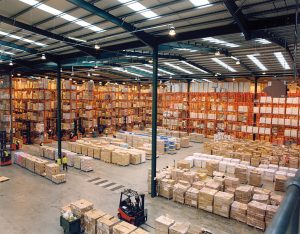5.1 Introduction

Learning Objectives
After reading this chapter, you should be able to understand and answer the following questions:
- Explain the importance of storage in Global Value Chain and the concept of Inbound and Outbound Storage.
- Offer Insights on how warehouses help in storage and role of technology in it.
- Discuss the importance of demand planning and Inventory Management in value chain.
- Describe inventory control systems and strategies used for ensuring optimal inventory levels.
Introduction
In this chapter, you will be explained about the importance of Inbound and Outbound storage in the global value chain. Storage of goods received by a firm is known as Inbound Storage, and storage of goods which are scheduled to move out of a firm is known as Outbound Storage. The concept of Material handling will also be explained with special reference to its importance in storage. Inbound and Outbound goods are stored in warehouses and distribution centers where they are managed using different concepts of Stock Keeping Unit, Electronic Data Interchange and cross-docking. For optimal space utilization in warehouses, an accurate demand forecast is essential. Techniques such as demand planning, Collaborative Planning, Forecasting and Replenishment, Value Chain Visibility and Value Stream Mapping could help avoid be helpful in avoiding shortages or excess inventories. Various Inventory Management Techniques were also discussed, such as Economic Order Quantity, Vendor Managed Inventory, Just In Time and Activity- Based Cost Analysis.
Assessing What You Already Know
Read through the case below and try to think of solutions to Wanda’s storage and process issues. To know more about the case, read the information contained in the document ‘Salty Pawz Background’.
Opening Case: Salty Pawz
Baking dog treats seems like a straightforward undertaking, and Wanda has never really given much thought to the process she uses. In fact, she produces her dog treats out of her kitchen the same way she did when she first started—one batch, one cookie sheet at a time.
She measures and mixes the ingredients in her trusty KitchenAid stand-up mixer, rolls them out on her counter using her mother’s old wooden rolling pin, and then uses cookie cutters to cut each biscuit out of the dough. Her oven will hold two cookie sheets at a time, and she does paperwork or checks email while they are baking. The only time it gets to be a hassle is when she does special-order “iced treats” and has to use the same mixer for the icing as the dough.
Once the treats are baked and cooled, she places them in a small cellophane treat bag. She threads a ribbon through a hole in a small card that has the company name and logo on one side and the ingredients on the other. She prints the cards off on her home printer, using some stock business card blanks she gets at the local office supply store. She then stacks the bagged treats into tubs she has sitting on her washing machine (which can be a hassle come laundry day), and there they sit until she is ready to pack and ship them to customers. Sometimes she worries that the ones on the bottom of the tubs are stale, but she figures dogs don’t know stale from fresh.
She wraps the bags of treats in a layer of bubble wrap, so they don’t get broken in shipping, packs them in boxes she gets from the office supply store, and prints out shipping labels on her computer. She makes at least one trip a day to Ship & Go to have them picked up by UPS later in the day. Ship & Go does not have “accounts,” so she pays for her packages every time she takes orders to be shipped. Once she is finished, it’s back home to mix up the next batch of treats!
Wanda doesn’t have much storage space, but she put shelving in her garage, where she stores the ingredients for the treats. She orders her chicken, bison, and lamb when her supply gets low, but all of the other ingredients usually come from the grocery store, unless Jamie is going to Sam’s Club and can pick up larger bags of flour and other ingredients. For the treats that contain vegetables, Wanda usually goes to Ed’s Farm Stand early in the morning and buys just what she will need for the day.
Salty Pawz is growing, and Wanda will soon expand to a commercial kitchen, which looks much more like a production facility than her small kitchen. She has never considered how her process will change when she makes the move. In fact, she hasn’t planned for it to change at all. She also has not considered inventory, storage, process flow, layout, or anything else related to production and operations management.
Media Attributions and References
Axisadman. (2007, Dec 11). Modern Warehouse with pallet rack storage system [Photograph]. Wikimedia Commons. https://commons.wikimedia.org/wiki/File:Modern_warehouse_with_pallet_rack_storage_system.jpg. CC BY-SA 3.0.

